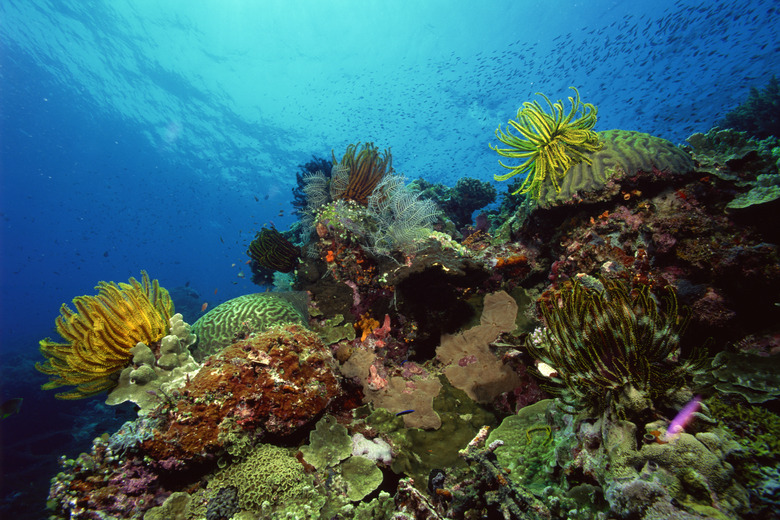What Habitat Do Feather Stars Live In?
Feather stars are sea animals that belong to the phylum Echinodermata and the class Crinoidea. A feather star is not the same as a starfish (also known as a sea star and sometimes misspelled as star fish). Close relatives of feather stars include sea stars, brittle stars, sea cucumbers and sea urchins. Feather stars inherit their name from the feathery appearance of their arms. A feather star habitat is slightly different from a starfish habitat.
TL;DR (Too Long; Didn't Read)
Feather stars, related to starfish and other echinoderms, typically reside in shallow water. Feather star habitats require the constant flow of ocean currents in addition to rocky substrates for the animals to use for feeding and for attachment.
Feather Star Habitat
Feather Star Habitat
Feather stars, also called crinoids, reside in the ocean, typically in shallow, warm waters. Some species do, however, exist in colder waters and deeper areas. A feather star habitat differs from a starfish habitat in a number of ways. A sea star or starfish habitat needs the right surface for the creature's feet to move across. Sea stars with tube feet reside among rocks, and sea stars with pointed tube feet tend to live on the seabed in sand or mud. Feather stars, however, live in areas with strong currents. They do not tend to live around silt, which can clog their feet. Living in areas with these currents ensures their survival, as they yield more opportunities to capture food. They may also swim through the water column if disturbed.
Feather Star Anatomy
Feather Star Anatomy
Crinoids represent one of the oldest forms of echinoderms and can be found in fossils dating back hundreds of millions of years. Like sea stars and other echinoderms, feather stars possess a form of internal skeleton. Calcium carbonate plates comprise this skeleton, which is covered by a skin. Ligaments and muscles hold the body together. Feather stars, like other echinoderms, exhibit radial symmetry, in which their mouths lie at the center of their several branching arms.
Feather stars, like their relatives, also have four body parts. These include the holdfast, to anchor to the seafloor; the stem, a muscle-filled part to raise the calyx; the calyx, which is cup-shaped and comprised of internal organs; and of course its arms. The arms vary in numbers based on fives. These branchlike, feathery arms are called pinnules. The arms curl in while the feather star rests and spread out when they feed or when they swim. Cirri represent tiny legs used for attachment of feather stars to substrates. Like starfish and other echinoderms, injured feather stars can regenerate their arms.
Feather stars rely upon their anatomy for camouflage, as they resemble their surrounding neighbors such as corals, sea anemones and plants. In shallow water, however, feather stars may exhibit vivid colors.
Feather Star Behavior
Feather Star Behavior
Male or female feather stars reproduce via water fertilization. Eggs, produced in spring, hatch as larvae. The swimming larvae eventually attach to the sea bottom via stalks. When they reach adulthood, they lose the stalks and can swim freely. In fact, these amazing creatures swim, float and "walk" through the sea. Feather stars swim by beating their arms up and down, or at times parachuting with their cirri out to grasp new substrate. When needed, however, feather stars can attach to rocks or other materials via their cirri. Feather stars previously were not considered fast movers. However, researchers revealed that feather stars could move as fast as 180 meters per hour. Feather stars use their fernlike arms to capture their food. In addition to perching on rocks, occasionally feather stars alight on other animals. Feather stars often hide concealed during the day. Predators of feather stars may include fish and sea urchins.
How Do Feather Stars Eat?
How Do Feather Stars Eat?
Feather stars eat at night, using their graceful limbs to retrieve food and nutrients from the sea around them. Their arms display numerous tube feet that can move and work as sieves for the water surrounding them. These secrete mucus. The feather stars wave their arms in the water, the arms capture plankton and other small detritus from the water, and the stars use their feet to transport the food toward their mouths. EAch tiny foot passes the food along to the next foot, starting with the most distant foot from the mouth. From there, a ball of food enters a U-shaped digestive system, with the mouth close to the anus.
The feather star habitat aids the fascinating creature's diet by providing constant movement of seawater and various substrates to which the animal attaches.
References
- Biodiversity of the Central Coast: Common Feather Star
- Marine Education Society of Australasia: Crinoids – Feather Stars & Sea Lilies
- University of California Museum of Paleontology: Introduction to the Crinoidea
- Scitable by Nature Education: The Freaking Awesome Feeding Habits of a Feather Star
- British Marine Life Study Society: Featherstars
- Australian Geographic: Feather Stars Are the Closest Thing We Have to Walking Plants
- Western Australian Museum: Marine Life of the Dampier Archipelago: Echinoderms
Cite This Article
MLA
Hermance, Dianne. "What Habitat Do Feather Stars Live In?" sciencing.com, https://www.sciencing.com/habitat-do-feather-stars-live-8792651/. 25 July 2018.
APA
Hermance, Dianne. (2018, July 25). What Habitat Do Feather Stars Live In?. sciencing.com. Retrieved from https://www.sciencing.com/habitat-do-feather-stars-live-8792651/
Chicago
Hermance, Dianne. What Habitat Do Feather Stars Live In? last modified March 24, 2022. https://www.sciencing.com/habitat-do-feather-stars-live-8792651/
